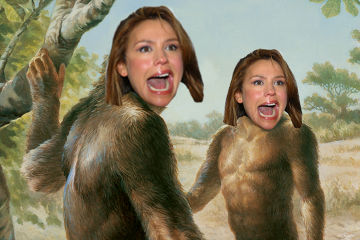What I’ve Learned:
“Australopithecus: In hominid evolution, you win some, you Lucy some.”
Australopithecus sounds like an oddball instrument some grimy dreadlocked dude from New Zealand would play — or possibly a disease you might catch from said grimy Kiwi dude, if you stood too close to him during the concert.
Happily, Australopithecus is actually a genus — that is, a group of species — that lived in southern and eastern Africa between about two and four million years ago. The term “Australopithecus” means “southern ape”, which is a reasonable description of these hairy prehistoric hominid furballs.
(Also, it’s probably not a bad description of that nappy New Zealander. I’m just saying.)
The Australopithecus species — including the famous “Lucy” specimen — are particularly interesting, because they’re the earliest fossil remains of ape-like creatures that weren’t particularly ape-like. Though they had relatively small brains, analyses of Australopithecus toes, feet and hips reveal that they could probably walk upright. They may have also played hopscotch and danced the lambada on steamy Saturday nights.
(Those last bits aren’t really supported by the science. I just like to picture them.)
Also, most Australopithecus species have powerful teeth and jaws not seen in apes, and some may have even used tools. So they were no longer true apes; they were more like apes crossed with crocodiles who could walk on two legs and work a can opener, but probably played a lousy game of chess because their brains were still the size of golf balls.
Or, basically a pack of slightly-hairier Rachael Rays. I apologize in advance for the nightmares that phrase will surely cause.
Thus, Australopithecus has answered one important question about human evolution: the adaptation to stand upright was not driven by the development of a big, human-like brain. Early hominids were walking (and cooking 30-minute meals, apparently) before they had the ginormous craniums we’re all so proud of.
But another question remains: were the Australopithecus species, the original bipedal hairballs, direct ancestors of modern-day humans? It depends on who you ask.
(Just don’t ask Rachael Ray. She’s kind of sensitive about it.)
On one hand, there’s good evidence that Australopithecus species walked upright, and they have several features — like particular bone shapes and relative sizes — intermediate between earlier species’ skeletons and those found in doctors’ offices and Halloween costume shops today. Some scientists say: if it mostly waddles like a prehistoric duck, and it vaguely quacks like a prehistoric duck, then slap a mammoth skin on it and call it Daffy. For them, chances are we have Australopithecuses in our family tree.
Other scientists aren’t so sure. “Upright” is one thing, but these pre-humans probably didn’t walk or run like we do, and likely still climbed trees and “knuckle-walked” on a regular basis. Also, there were still Australopithecus species hanging around after the Homo genus emerged about 2.4 million years ago. Did the Homo species, including Homo sapiens — i.e., every human on the planet, except possibly Carrot Top — evolve from one of the earlier Australopithecus groups? Or intermingle with a later one? Did we evolve from a common ancestor, then watch their branch die out over the millennia?
At this point, nobody knows for sure. More fossil specimens — like the new species Australopithecus sediba, described in 2010 — may someday provide conclusive evidence of a link between the genuses. That would be exciting news, indeed.
Except then we’d have to invite Rachael Ray to the family reunions. And nobody wants to be at that potluck, Junior. Pass the prehistoric potato salad.



